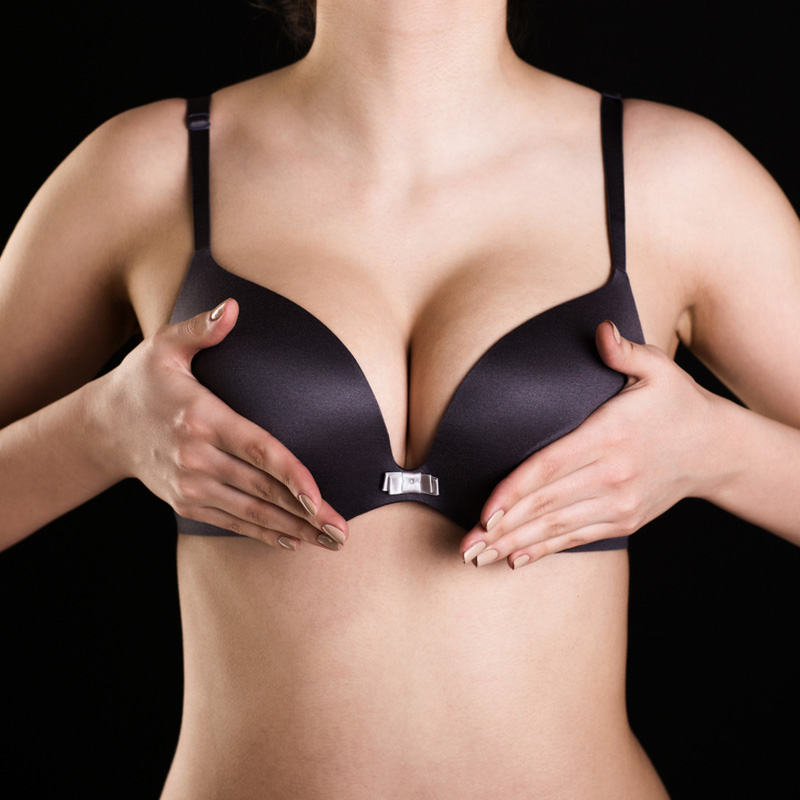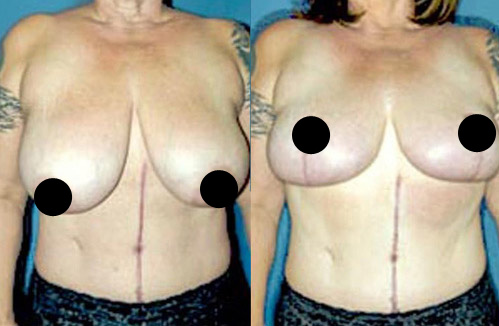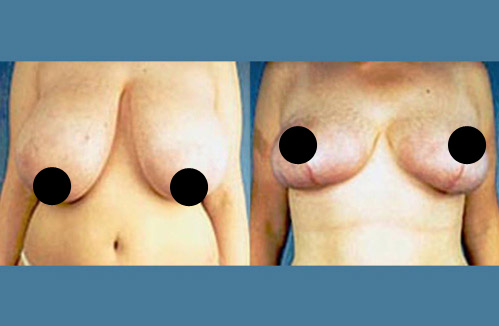Breast Reduction


What Is Breast Reduction?
Breast reduction can do more than reduce pain. When performed with a breast lift, a lively shape can be restored to your breasts, creating a whole new you.
Table of Contents
Breast Reduction Procedure Overview
The specific technique used to reduce the size of your breasts may vary. However, most of the steps remain broadly the same.
Anesthesia
The vast majority of breast reductions are performed under general anesthesia. This means you will be asleep during your entire surgery. Local anesthesia is mostly used in liposuction/liposculpture procedures.
The Reduction
Your procedure will last anywhere from one to three hours. The precise length of the surgery depends on the number of incisions and the amount of skin and tissue removed.
Though there are a variety of breast reduction techniques, most surgeries involve removing tissue from your breast and realigning your nipple area. Dr. Brent removes the excess tissue, fat, and skin to reduce the size of each breast. Then, he moves your nipple and areola into their new position. Lastly, he brings the skin from both sides of your breast down to shape and contour your new breast.
Cosmetic contouring may be used to remove excess fat from your armpit and lateral chest area to give you a more aesthetic appearance at this time as well. Dr. Brent finishes the procedure with precision incision closure using sutures.
Afterward
Once the procedure is complete, you will be taken to a room to recover from your anesthesia before traveling home. Of course, Dr. Brent will check on you before you leave. Once you are ready, you can return home with your arranged driver.
Types of Breast Reduction Procedures
The type of reduction you will need depends on your unique situation. During your consultation, Dr. Brent will go over the available options and recommend which would be best for you.
The Wise-Pattern Reduction
The Wise Pattern breast reduction technique is the original procedure. It removes skin, fat, and tissue from your lower breast area to reduce the mass of your breast. This procedure works well on women who are looking to reduce the size of their breasts significantly.
Vertical Incision
The vertical technique requires less surgical time, a shorter healing period, and less scarring. All of this has caused this option to grow in popularity. It provides balanced reduction and works for a wide range of patients.
Liposculpture/liposuction Only
This technique involves using liposuction only. The excess fatty breast tissues are extracted, decreasing the size and weight of your breasts. This technique leaves less physical trauma to the breast tissue and has a minimal risk of complication and scarring. It is best for patients who need only mild reduction.
Stevens Laser Bra
Dr. Brent creates an internal bra from your own tissue to produce a permanent support system. The result is a more natural effect for patients in the long term. The Laser Bra is attached internally to your chest wall, creating an internal bra support structure. When done right, you will not be able to see or feel it.
Breast Reduction With Lift
Most women interested in breast reduction also benefit from a breast lift. it can successfully remove excess tissue. But, this alone will not bring your breasts back to a desirable position on your chest. That is why breast reductions are often combined with a breast lift so that your new, smaller breasts are situated higher up on your chest for an attractive and more youthful appearance.
Breast Reduction FAQs
How should I prepare for breast reduction?
Proper preparation for a surgery helps promote an all-around safe and positive experience. While these steps are simple, they each contribute to a procedure that minimizes risk and maximizes benefits.
- Obtain bloodwork and other required tests
- Schedule time off from work
- Arrange for someone to drive you home from surgery
- Arrange for someone to help you around the house for the first couple of days
- Pause medications as recommended
- Avoid any blood-thinning medication or supplements
- Ask for clarification on any elements of the process
What is the recovery timeline like after breast reduction?
The total time of recovery can vary depending on your unique procedure. However, below is an outline of what the usual recovery and downtime look like.
Week 1
The first days after surgery will require a lot of rest. Your breasts will be slightly bruised and swollen. Dr. Brent will prescribe medication for your pain and discomfort if you need it. You will need to take time away from work and social engagements.
Week 2
For the first two weeks, it is very important to avoid any physically strenuous activity. After the first week of recovery, the swelling and bruising will subside, and you may return to a basic routine. We usually see patients for their first follow-up appointment toward the end of the second week.
Weeks 3–4
Continue following your post-op instructions. At the end of the fourth week, your scarring will have notably subsided. The long-term results of your surgery will begin to be visible. You can gradually return to your full routine and physical activity.
What are the results like?
Your new breast size should help relieve you from the pain and physical limitations experienced before your breast reduction. The results of your surgery will be long-lasting. And, your more natural-proportioned figure will boost your self-confidence.
Patients will start to enjoy the benefits about 2 weeks after surgery. By this period, your breasts should have greatly healed and will feel more comfortable. You can also start returning to some physical activity, and the change in weight and balance will feel stark. Other symptoms, such as rashes and bra-strap lines, should also resolve.
Keep in mind that residual swelling can take several months to fade. This swelling will not be highly visible, but it does affect how the breast tissues feel and sit. As it fades, your breast tissue will settle into position, and you will see your full results.
What size will my breasts be after surgery?
The final size of a patient’s breasts after reduction will depend on their individual plan. Most patients will have a reduction that results in 1 to 3 cup sizes down from their original size. Typically, patients aim for a C or D cup following reduction. At this size, most patients can experience symptom relief without too much change in breast size. Techniques differ according to the amount of breast tissue to be removed, which will affect the final difference in cup size.
Are the results permanent?
Breast reduction results can last a lifetime. However, the size and position of the breasts can still change due to various factors. One main one is weight gain. Maintaining a stable, healthy weight can keep your breasts at a comfortable size. Certain medications and hormonal changes can also affect breast size, which Dr. Brent can discuss with you during the consultation or follow-up. However, the removed breast tissue will not grow back.
Will the procedure leave a scar?
Any incisions made during a surgical procedure heal as scars. However, a skilled surgeon will work to minimize their visibility. Whenever a technique allows, Dr. Brent makes hidden incisions. When an incision is made in a visible location, Dr. Brent focuses on size and shape. He always makes the smallest incision possible. Additionally, the shape of the incision follows the breast’s natural curve, reducing how much it stands out.
Fortunately, scars do fade over time. To minimize scarring, patients can:
- Follow all post-procedure instructions to facilitate optimal incision healing
- Utilize nonsurgical treatments to reduce scarring (creams, laser treatments, etc.)
Am I a candidate for a breast reduction?
If you experience even minor discomfort from the size and weight of your breasts, a reduction surgery could help. Also, if you are unhappy with a difference in the sizes of your breasts, a reduction of a single breast can help you achieve balance.
Below, we lay out a few conditions that signify breast reduction could benefit you. You are a candidate if:
- You feel self-consciousness about the size and shape of your breasts
- One breast is much larger than the other
- You experience back, neck, or shoulder pain caused by the weight of your breasts
- Bra straps cause indentations in your shoulders
- Physical activity is restricted due to the size and weight of your breasts
- You experience frequent skin irritation or skin rashes beneath your breasts
Candidates must also meet a few qualifications. These include not smoking, being at a stable weight, and being in overall good health. During your consultation, Dr. Brent can discuss your expectations. He will work with you to determine what procedure best fits you.
What is the right age for breast reduction?
Many patients can develop overly large breasts even at a young age. Living with the condition for years only contributes to longer-lasting symptoms and issues. We recommend patients seek medical care earlier rather than later to avoid years spent with chronic discomfort and other symptoms.
However, patients do need to reach a certain developmental point before having the procedure. Usually, patients should be at least 18 years old before having reduction surgery. By this age, the breasts should have finished developing. While younger patients may have the procedure, a few additional requirements are in place. Minors will need the consent of a parent or guardian. Additionally, at least a year should pass after the breasts have finished developing before having a reduction.
Will breast reduction affect breast function?
Two concerns many patients have include the procedure’s effects on breastfeeding and nipple sensitivity. Milder breast reduction can preserve both of these functions in many cases. However, more extensive reduction can impact breast function. Dr. Brent openly discusses these elements during the consultation, allowing you to weigh the benefits and trade-offs of different approaches.
How much does the procedure cost?
Breast reduction cost factors in the surgeon’s experience, facility fees, anesthesia, and individual procedure elements. The consultation allows you to build a tailored treatment plan with Dr. Brent, which includes a full quote. Each quote we provide breaks down cost elements in a clear and straightforward manner, so you will have no surprise expenses after committing to surgery.
Does insurance cover breast reduction?
For many patients, breast reduction counts as a medically necessary procedure. It alleviates legitimate medical symptoms and can lead to lifetime relief from chronic pain. As such, many insurance providers do cover at least part of the procedure. Coverage varies, so we recommend patients contact their insurance providers to learn about what their plan entails.
Schedule a Consultation Today
If the size of your breasts has been giving you issues or decreasing your quality of life, schedule a consultation today. Learn about breast reduction and see if the procedure is right for you. Dr. Brent, Beverly Hills Plastic Surgery, and his team of professionals are ready to discuss your expectations. Together, we work with you to develop a personalized plan.
We understand that this can be a big step in your life. Our goal is to provide an informed and comfortable experience that leads you to the body you deserve.


